Megaton Musashi W: Wired Review
After reportedly winding down Level-5 International America and its Level-5 Abby spin-off office in 2020, developer Level-5’s western presence vanished for the past few years. During this dormancy, the company had been setting the stage to make a big comeback. With planned worldwide releases for upcoming new entries in their Inazuma Eleven, Fantasy Life, and Professor Layton series, along with a brand-new IP through DecaPolice, Level-5 is clearly intent on becoming an international competitor once more.
The path to the western release of Megaton Musashi W: Wired is equally fascinating as it is befuddling. Megaton Musashi was originally a Japan-exclusive game released in November 2021 for the PlayStation 4 and Switch as a traditionally priced game with extensive content updates after release; its sequel, Megaton Musashi X, launched the following year as a Japanese-only free-to-play game containing all the content from the original Megaton Musashi and even more new updates, as well.
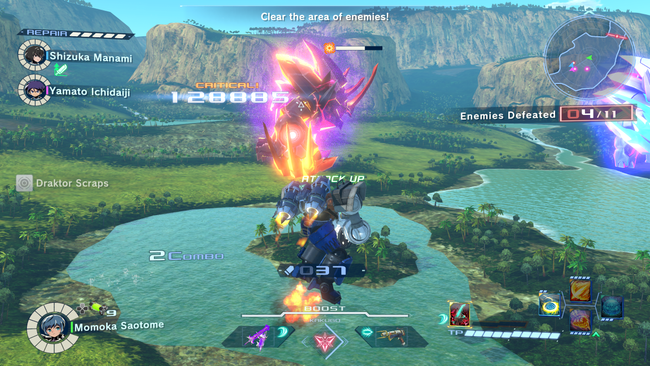
Now with Megaton Musashi W, the series has returned to being a priced game with all the content and updates of Megaton Musashi and Megaton Musashi X included, plus several new features introduced in this latest entry. Now released globally, players worldwide benefit greatly from this “definitive version”, because it is filled to the brim with content from the get-go.
I didn’t know what to expect from Megaton Musashi W going in. Its prior releases caught my eye since I’m a big fan of mecha, but this IP always felt troubled from an outsider’s perspective. The first game was initially slated for a summer 2017 release, lackluster sales in its launch week, a sequel that pivoted to a free-to-play model, and numerous delays at some post-launch updates for both prior entries just seemed like this series faced a tremendous amount of challenges repeatedly.
Here I am, over 50 hours later, to report that Megaton Musashi W is one of my favorite games of 2024. Megaton Musashi W has a lot going for it: an intricately compelling story driven by an interesting cast, an addictive loot-driven action RPG gameplay loop, myriads of complex progression systems, many different mechanics that unlock over time, and frankly, this title also possesses a handful of core features that should be a base standard for other titles in this genre.
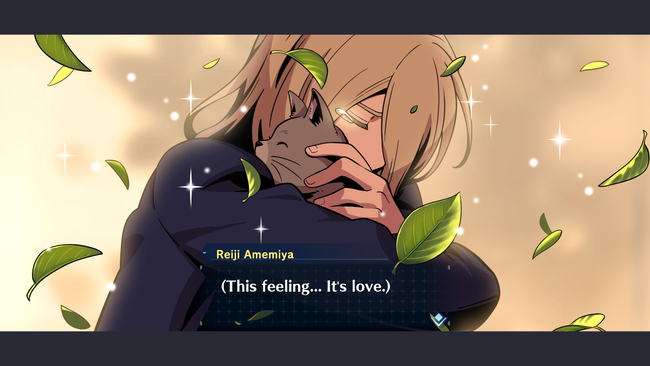
Before diving into what I love about this hidden gem, I’ll address the various elephants in the room.
This game launched with roughly $125 US dollars worth of DLC; none of it is necessary to make it more enjoyable. The bulk of it is purely cosmetic and the ones with robots are special recolors of existing ones in-game that quickly become obsolete.
Unfortunate remnants of the free-to-play elements from Megaton Musashi X still manifest in minor ways, such as a daily login bonus and battle pass. Both only provide basic materials and minor resources that can be obtained in other ways inside the game itself. They do not reward anything that affects or hinders the game experience on a fundamental level. The most intrusive thing about them is a second “premium” battle pass that is paywalled behind the Deluxe Edition. I didn’t buy the Deluxe Edition and none of that stuff seemed worth the additional cost either.
I’m quite aware that seeing these systems without any context leaves a bad first impression and I wish Level-5 took them out of Megaton Musashi W outright. Nevertheless, I hope that people can look beyond that to find what makes this action RPG an absolute blast to play.
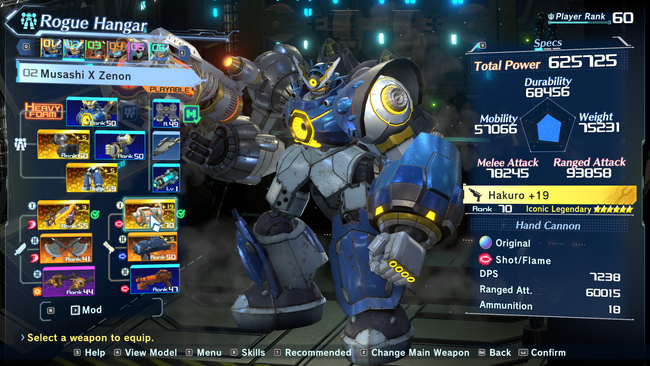
Although Megaton Musashi W possesses the Saturday morning cartoon energy in its visual presentation that would normally cater to Level-5’s younger demographic, the story is surprisingly dark. Players primarily witness the narrative through Yamato, a normal high-school boy who enjoys fighting.
Before the first mission begins, people will see Yamato thrown in jail, break out of said jail, nearly get assassinated by a classmate now possessed by an alien, almost get beaten to death by androids that were disguised as people, get recruited to become a giant robot pilot because he prevailed against said androids, and find out that everything he knew up to this point was a lie.
An alien force known as the Draktors invaded Earth and wiped out 99.9% of humanity several years before the game began. The town Yamato resides in is actually a dome-enclosed shelter called the Ixia. Those who operate Ixia have brainwashed its residents in order to wipe away the deep-rooted mental scars and trauma from the Draktor invasion, so they could continue to live a normal life peacefully. Meanwhile, they desperately fend off the Draktor forces outside the shelter with a military force that operates giant robots called Rogues.
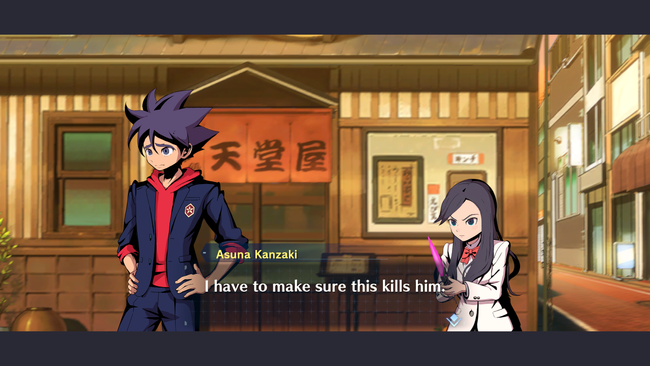
Once again, this is all established before the first mission of Megaton Musashi W. Yamato initially declines the offer to join the defenders, but they forcefully strap him to a device that gives his real memories back. He remembers how his family was brutally slaughtered by the alien forces; his little sister was crushed right in front of him. This naturally fills Yamato with rage and drives him to fight back.
Separating the more morally questionable aspects from the setup, such as manipulating someone to become a child soldier, it may seem like a rather bog standard premise for a science fiction story. Don’t worry, it only gets more insane.
I was shocked multiple times at the continual plot twists that unfold throughout Megaton Musashi W. Though it isn’t as elegantly executed as 13 Sentinels: Aegis Rim, there are moments in this game that emanate the same energy that 13 Sentinels captured. Intriguingly, Megaton Musashi W is relatively more daring in some of the character relationships and narrative themes it presents.
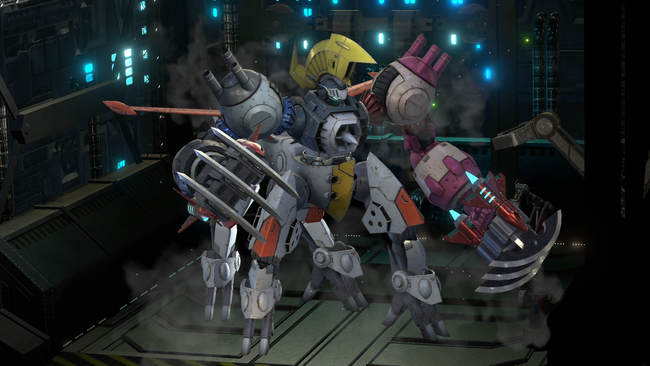
A large chunk of the plot isn’t just focused on the current state of humanity, but also the perspective of the Draktors, as well. Megaton Musashi W ultimately proposes a seemingly unthinkable question - can humans and Draktors end the cycle of violence and pave the path to the future forward through coexistence? Numerous scenes filled with character drama and political intrigue build toward this as the game fleshes out many of its cast members.
As I mentioned earlier, Megaton Musashi W contains the entire stories from the prior Megaton Musashi and Megaton Musashi X installments from where they began and ended. This includes all the updates to the main story that were added after they launched.
From its conception, the Megaton Musashi series was built as a multimedia project. Both prior Megaton Musashi releases existed alongside two seasons of a TV anime that covered the same story. Therefore, there are several anime video cutscenes weaved into its presentation; even one of the final parts of the story is presented through a full-length nearly 30-minute anime episode. Some of the messy and uneven issues in its story flow can be attributed to this aspect.
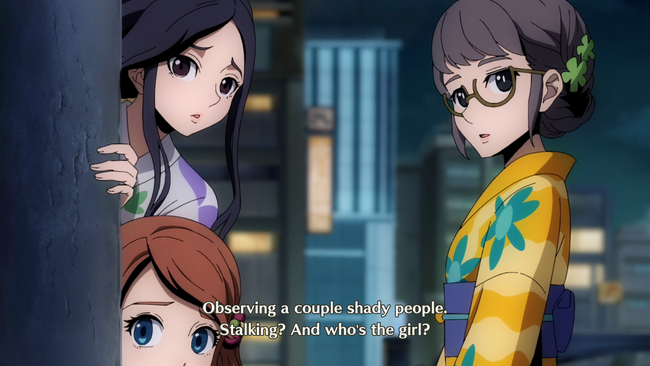
Its rushed pacing becomes more prevalent in the last quarter of the plotline that originally concluded Megaton Musashi X as it tried to wrap things up rapidly. The bulk of my disappointment with its story, however, is actually the new additional main story arc added in this new Wired release.
This was the prime chance to properly deliver on lingering narrative plot threads and Level-5 massively missed the mark. Lasting barely two hours, the new main story elements blitz through events at an unbelievable rate. A lot of the developments that transpire are bafflingly executed poorly; it saddens me because I think a lot of it might have been more meaningful or impactful if it was given the time to properly build towards it. Obviously, I can’t go more deeply into narrative specifics because of immense spoilers.
Regardless, I still enjoyed my time going through the story and I ended up liking most of the characters. Fans of older mecha anime, such as Getter Robo, Mazinger Z, and Voltes V, will appreciate the similar energy that Megaton Musashi W brings to the table. Those series even show up as playable cameo Rogues in the base game itself, not as separate DLC offerings.
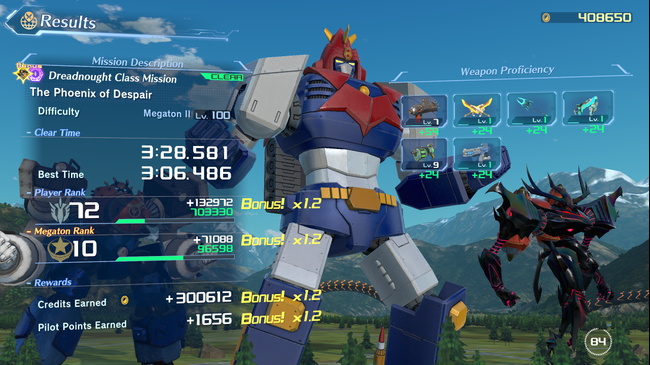
As players progress through the plot, they’ll start to control other cast members to witness events unfold from their perspective. There’s even a route split that happens later on, in which people take control of a secondary team to move the narrative forward. I think Megaton Musashi W’s story is bold and entertaining, despite fumbling the landing.
Perhaps the thing that caught me the most off-guard with Megaton Musashi W is the production values in the adventure game segments in-between combat missions. I thought this title would be structurally paced like the Gundam Breaker games, which kept a steady rhythm of getting people going from mission to mission in quick succession; this often came at the cost of having their narrative elements take a backseat which made them serviceable story-wise, but most of them weren’t necessarily memorable.
Story missions in Megaton Musashi W have players running around in a 2.5D sidescroller throughout various parts of the city inside the Ixia shelter to see the next story event. An extensive fast-travel option is available to get there immediately if players want, though I personally didn’t use it most of the time for several reasons which factor into why I appreciate the game’s production values in this regard.

There is an astounding amount of care put into all of Megaton Musashi W’s backgrounds; there aren’t any duplicated or standard “default” backgrounds that are readily noticeable. Every building that can be entered possesses a unique interior, every district has a variety of visually distinct shops, and even places that are rarely utilized still have fully-featured defined backgrounds.
This bleeds over into the numerous pieces of unique artwork to depict special moments in the story. Several key scenes have an entire piece of new art that only existsfor a single line of text - never to be seen again.
Even hearing what NPCs have to say in Megaton Musashi W had that same feeling of the developers going the extra mile, almost needlessly from my point of view. While several NPCs are named, most of them go by a descriptor to add a contextual flavor to their spoken dialogue. My favorite NPC, the Girl with Unique Ideas, has told me her wishes to drop caramel onto a stadium full of pudding from a helicopter, to become the best at slipping on a banana peel race, and to invent an inverse mermaid that has human parts at the bottom part of their body. These are nonsensical, but I supported the Girl with Unique Ideas and looked forward to whenever she had something new to say.

She isn’t the only unique NPC to do this either; there are many NPCs that have quirky descriptors that add personality to the mind-wiped residents of Ixia going about their daily lives. They are all fully voiced, as well as the rest of the entire game. I remain in absolute awe at Level-5’s commitment to fleshing out something that, realistically, doesn’t contribute much when considering the overall package.
I recall a scene in the story where two characters entered a resident’s home to have dinner with them. This segment featured an anime cutscene and I noticed that the video showed the kitchen with 3 bowls stacked by the sink, a pair of red scissors hanging in a certain way, the position of the curtain, and the color of the curtain sheets. I wondered if the game’s background matched up with how the anime depicted it. Sure enough, when it returned to the in-game scene, the background details matched up identically nearly 1:1. I was floored.
Other than admiring these details, the gameplay elements associated with the adventure sections are rather rudimentary. Basic side quests have people travel from point A to point B and often open up new sections of the map. There are several unlockable vendors that only accept certain collectibles as currency. Resources can be collected from sparkly nodes that shine in the environment.

The most substantial elements are the additional Side Stories that grant specific members of the cast their own fun light-hearted storyline. At first glance, it seems annoying to unlock them because they (and any other subsequent chapters of them) require four of a specific collectible that is exclusive to that Side Story. Luckily, there is an in-game index that specifically lists the exact location of where each of these collectibles can be found, along with the collectibles that the aforementioned vendors accept.
One odd design decision I noticed when running around is that there’s usually no background music playing during these parts. Megaton Musashi W normally does a terrific job employing a handful of different themes to steer the mood of scenes, often delivering tracks that foreshadow an incoming conflict or moments of triumph. Leaving the adventure game segments mostly muted stuck out to me the more I played because the title typically exudes personality otherwise.
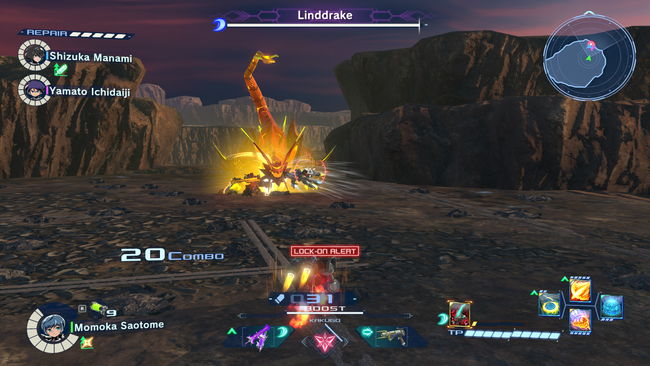
Megaton Musashi W, above all else, is just downright fun to play - though it does take a few hours to find its stride. It is an extremely easy ride until higher difficulties unlock at a certain point in the campaign. The combat system itself starts very simple, with buttons for melee attacks, ranged attacks, dashing, jumping, guarding, locking on, and switching weapons; up to three different melee weapons and ranged weapons can be equipped.
Each Rogue can equip up to four special moves that all consume TP, which can more-or-less be treated as the MP bar equivalent. Eventually, a total of three Rogues can participate in a mission and players can switch between them instantly in the middle of combat.
Enemies have elemental weaknesses that don’t truly become important till much later, though inflicting them can cause status effects such as burn, freeze, and stun.
This is only the bare minimum as the action RPG begins to stack battle mechanics such as air launchers, guard breaking, repairing broken parts, combination moves, Kakugo passive buffs, super Kabuki Function attacks, and mastering boost movement to evade attack markers. Characters will constantly be yelling the names of special attacks in a hot-blooded manner once the flow of combat continually speeds up.

I love how broken parts are handled here because it applies a different debuff depending on which part of the Rogue is malfunctioning. The minimap and lock-on functions are disabled if the head is broken and the Rogue moves extremely slow if the legs are broken, for instance. To repair parts, players have to stay stationary, enter the cockpit view, select the repair function, and choose which part they want to begin repairing before entering the fray once more.
Doing this does not pause combat at all; it must be done while everything is still moving in real-time, so players have to tactically consider when they can spare 2-3 seconds to repair a part. Multiple parts can be simultaneously malfunctioning, too, so the decision extends to which part should take priority to repair first. The way it’s executed perfectly intensifies the chaos as battles escalate into a feverish frenzy without crippling people in a fashion that will instantly just kill them and the momentum along with it.
Of course, the moment-to-moment gameplay is only a small part of the equation. The number of ways to build, customize, and finetune a Rogue in Megaton Musashi W is absurdly deep and robust.

Players are given complete freedom in how they want to build their giant robot squad. Sometimes the story won’t allow newly introduced Rogues to be customized immediately but eventually, the action RPG will let people tinker to their heart’s content. Rogues are composed of four parts: head/torso, left arm, right arm, and legs.
As I mentioned earlier, a single Rogue can equip up to three melee and ranged weapons. Additionally, a slot for a backpack thruster opens up at some point. Melee weapon options consist of sword & shield, dual swords, lances, greatswords, and fists; meanwhile, ranged weapons contain shotguns, hand cannons, machine guns, and bazookas. Some types allow for charged attacks that can alter the properties of an attack.
As people thrash foes in stages, loot of various color-coded rarity tiers will burst from them. Randomly mashing together whatever gives the highest number immediately will naturally work to breeze through the early parts of the game; after some time, players will be expected to start working toward coordinated builds that amplify certain damage types and consider elemental weaknesses more seriously. Each Rogue has multiple set bonuses, so matching all the parts of specific ones is important to think about once the challenge level ramps up.

Aside from higher base stats, higher loot rarities will have more mod slots to put into them. Mod modifiers can raise damage of a certain element, add more ammo to ranged weapons, raise critical damage, and so on; they provide extra avenues to raise offensive and defensive capabilities. These mods drop from enemies, too, but similar rarities can be combined to make higher rarity mods.
The real meat of defining a Rogue’s build is the extensive motherboard mechanic in Megaton Musashi W. Basically, people choose a motherboard blueprint and puzzle together various circuit parts to specialize what that Rogue excels at. Supplementary pieces can further enhance adjacent parts exponentially.
A motherboard layout, for example, can magnify melee damage output up to 500% because nearby slots can support circuits that increase the efficacy of circuits within a designated area; these can overlap with other raised efficacy zones to stack on top of one another. Since these usually affect a wide area, nearby vacant slots could be utilized to raise elemental damage, reduce incoming damage, or increase TP recovery so abilities can continually be fired off.
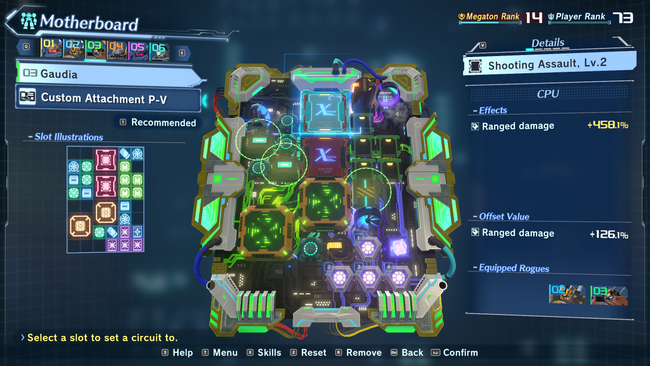
This is just a very small sample of what’s possible. Motherboard circuits are obtained through a large branching development tree that consumes materials to unlock additional nodes. Duplicate motherboard parts, more special attacks, new moves that expand a weapon type’s moveset, and myriads of other functions are available to learn on it. All of this can, understandably, seem intimidating at first, so there is a feature that automatically slots everything in; it’ll be far from optimal, but it will get the job done for the easy earlier parts of the game.
Even more mechanics are given to players once the Legendary-tier parts become more prominent as it allows people to overlimit them beyond the standard route of upgrading equipment. The three new postgame rarity tiers added to Wired with Legendary 2, Iconic Legendary 2, and Relic Legendary have an exclusive Neural Board function that further boosts their power. Near the end of the story, an entirely new roguelite-esque mode unlocks which is the primary method to acquire a new type of part, adapters. These, once again, provide an additional way to enhance the power of Rogues.
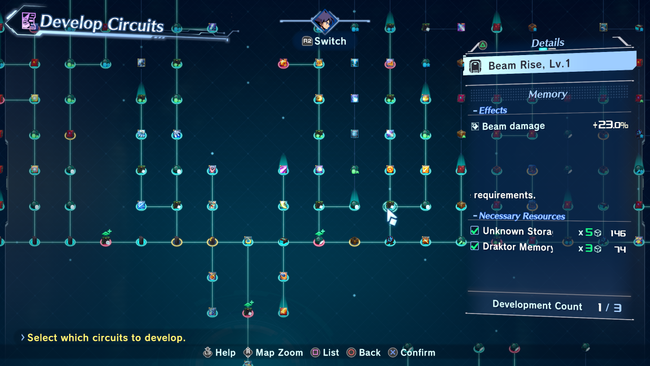
Frankly, there is just a dizzying amount of systems on top of systems that I had to wrap my head around, but I love this kind of in-depth customization because I could feel that my efforts were rewarded in gameplay. If I was tuning a Rogue to specialize in ranged attacks that generate TP swiftly, the results were immediately noticeable. I was firing off special attacks without a second thought as the TP could be replenished in mere seconds.
Furthermore, players earn Pilot Points (PP) to learn new skills for each character. Every character has a completely different set of skills to invest in. Each skill can be shared with one other character, as well as the character that skill originates from.
Rogues will inevitably be visual monstrosities for a fair bit as people mash together parts that drive their power level up as fast as possible. Megaton Musashi W does eventually allow people to recolor individual parts or transmogrify their appearance altogether. Decals allow people to further decorate their Rogues; even different keychain charms for the cockpit view are available in the two seconds it’s glanced at when repairing a broken part.
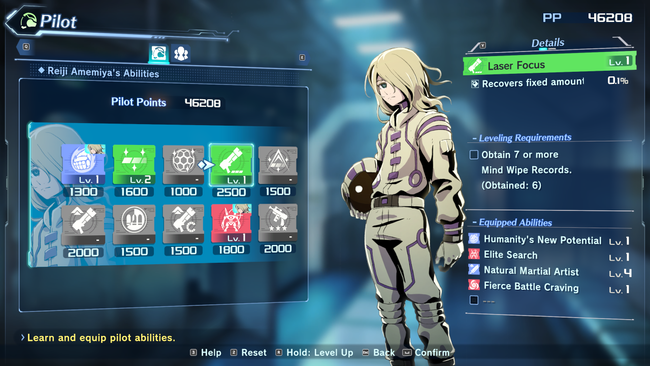
While it wasn’t a devastating make-or-break Achilles' heel in my experience, the repetitive mission design of Megaton Musashi W does wear thin. Almost all of its stages are simple linear levels that have players kill waves of enemies, move into the next area, and do the same thing until a boss spawns to signify that the end of the stage is just around the corner. More stage variety kicks in much later as the overall mission design shifts to focusing on single, complex boss encounters that switch up their attack patterns at certain HP thresholds. Even then, the stage environments themselves are disappointingly bland; serviceable, yet not that visually captivating.
Though story missions are single-player only, the huge plethora of optional side missions can be played in online co-op with up to two other players. Two of the big features that Megaton Musashi W has been pushing since its announcement are cross-play and cross-save between its PS5, PS4, Switch, and PC versions. I played the game on PC and was able to play with other players on different platforms seamlessly without an issue. There are icons by players’ names that signify which platform they are playing on.
One of the coolest things in Megaton Musashi W is allowing previous Megaton Musashi players to move their saves forward into the English release. I’ve heard from several of my friends, along with other anecdotes, that they were able to transfer their saves from the Japan-only releases of Megaton Musashi and Megaton Musashi X into the English release of Megaton Musashi W. Level-5 provided an official in-game method to facilitate converting their saves not only to this newest version, but onto a different platform altogether because of the cross-save functionality. I find that incredible.
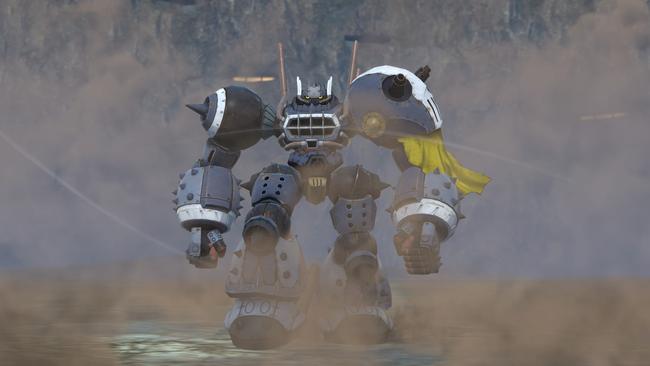
Megaton Musashi W also boasts an optional, extensive PvP colosseum that allows two teams of three to duke it out. Players build up a new Rogue from scratch with completely separated PvP-exclusive parts and even a PvP-exclusive skill tree, so progress isn’t strictly shared aside from the new story-locked mechanics that are added to the core battle system. It seems like a considerable part of the game with substantial depth, but I was unable to play much of it due to long queue times to find matches with cross-play on.
Sadly, Level-5’s marketing efforts in the west for Megaton Musashi W have been nearly non-existent, so its current playerbase is rather small. Another factor to consider is that the game simply has so many other things to do that it further dilutes the playerbase even further, as several players may not even touch the multiplayer modes.
Some other quality-of-life features worth mentioning are the ample options to quickly construct a workable Rogue for those who don’t want to manually pick out every single part from scratch. There are recommendation options to quickly select sets of weapons to target enemy weakness right before entering a mission without going to the hangar which is handier than it seems. Meanwhile, it even has an option to pick out recommended weapon sets based on how well they synergize with a specific Rogue’s set bonus.
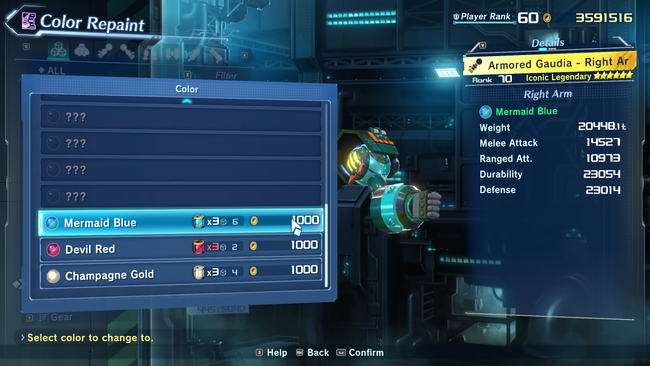
Another small feature that I have rarely ever seen other games do is a button input to skip voiced in-game battle dialogue to the next line. That may not seem useful at first, but there are many times throughout Megaton Musashi W’s narrative when a new feature is unlocked in the middle of a tense fight. Bosses may be invincible till this new move is activated for the first time and the characters chime in as they make the proper preparations to debut it. Other games usually would have to let players wait for all the voiced lines to completely finish before proceeding, so this was a tiny welcome surprise.
The PC port of Megaton Musashi W is quite solid as well, with support for high framerates and I suffered no technical issues on my end. Level-5 unexpectedly went above and beyond as the game adapts its UI navigation based on the input it detects. If a mouse or analog stick is being used, it will display a cursor that can navigate across the screen; the d-pad and triggers will switch the navigation method so selections can be made by snapping to them instead of forcing a single universal method that’s suboptimal or inconvenient for one type of input altogether.
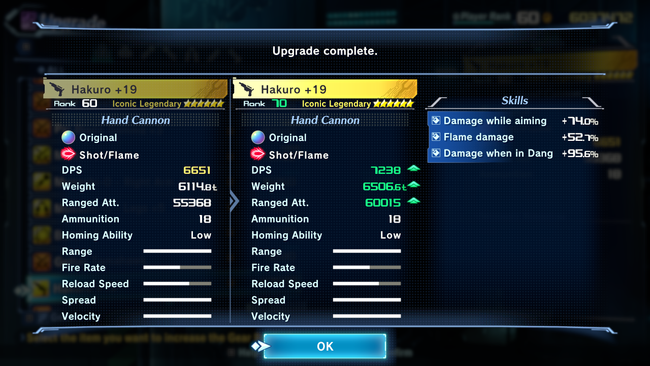
Megaton Musashi W: Wired is unexpectedly, and surprisingly, one of the best action RPGs in 2024. It offers a lengthy main storyline filled with amusing characters, a plethora of rich in-depth customization mechanics to supplement its compelling gameplay, multiple modes that all serve to enhance what makes it fun, and a ton of smartly designed navigation functions that lead to a smooth experience in moving around its dozens upon dozens of menus. While the narrative stumbles at the finish line, it is undeniable that Megaton Musashi W: Wired is one of the most fully-featured video games in the modern era that is filled to the brim with stuff to do and it is all fun as hell.